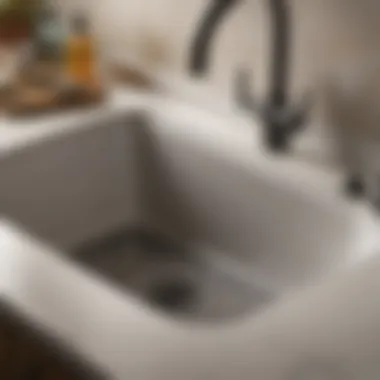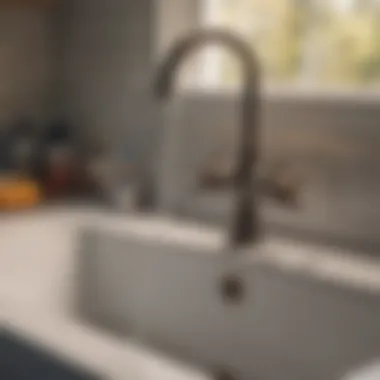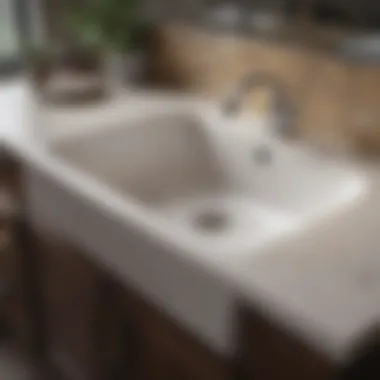Effective Strategies to Unclog a Completely Clogged Sink


Intro
A completely clogged sink poses a significant challenge for any homeowner. Beyond being a mere inconvenience, such blockages can lead to further plumbing issues if not addressed promptly. This article aims to empower you with knowledge and practical solutions for unclogging your sink effectively. With strategies ranging from basic to advanced techniques, you will learn how to tackle serious drainage issues head-on. We will discuss key tools required for the task, provide step-by-step methods for unclogging, outline preventative maintenance tips, and when it might be time to seek professional help.
Each method outlined will provide you with the capability to restore your sink's functionality while also enhancing your understanding of plumbing systems. As we progress, expect to find an array of procedures that can save both time and money, allowing you to take control of your home maintenance.
Essential Tools
Before diving into the unclogging techniques, it is vital to gather the necessary tools. Having a prepared toolkit will make the process more efficient and reduce frustration. Some essential items include:
- Plunger: A basic yet effective tool for many clogs.
- Drain Snake: Useful for deeper blockages that a plunger cannot reach.
- Bucket: Helps in managing spills during the unclogging process.
- Rubber Gloves: Protects your hands from debris and harsh chemicals.
- Baking Soda and Vinegar: Natural remedies for minor clogs.
Step-by-Step Unclogging Procedures
The approach to unclogging a sink will vary depending on the severity of the blockage. Here are steps for a basic to a more advanced method:
- Simple Plunge:
- Baking Soda and Vinegar Method:
- Using a Drain Snake:
- Professional Help:
- Place the plunger over the drain.
- Ensure there's enough water in the sink to cover the bottom of the plunger.
- Push down firmly and pull up in a rhythmic manner.
- Pour half a cup of baking soda down the drain, followed by half a cup of vinegar.
- Allow it to fizz and work for about 30 minutes.
- Flush with hot water.
- Feed the snake into the drain until you reach resistance.
- Turn the handle to break up the clog and pull out any debris.
- Run water to ensure the line is clear.
- If these methods fail, it may be time to consider calling a plumber. Persistent clogs could indicate more serious plumbing issues that require expert intervention.
Preventative Maintenance Strategies
To minimize the chances of future clogs, consider implementing the following strategies:
- Dispose of grease and large food particles in the trash instead of the sink.
- Use sink strainers to catch small debris.
- Regularly maintain the sink with baking soda and vinegar treatments.
Culmination
Understanding the Clog
Understanding what causes clogs is fundamental when dealing with a completely clogged sink. This section delves into common sources of clogs and the mechanics behind drainage systems. Recognizing these issues helps homeowners identify problems quickly and save time and money on plumbing solutions. By addressing the underlying causes, one can prevent future clogs.
Identifying Common Causes
Accumulation of Hair and Soap
Accumulation of hair and soap is a prevalent cause of sink clogs. Hair easily intertwines with soap residue and forms a dense mass in drains. This combination creates a barrier that restricts water flow, eventually leading to blockage. Hair and soap clogs often occur in bathrooms, making it critical to recognize their role in drainage issues. Implementing routine cleaning can mitigate this problem.
Grease and Food Particles
In kitchens, grease and food particles are notorious clogging agents. When greasy substances cool, they solidify, sticking to pipes and trapping food remnants. Over time, a significant buildup impairs drainage. The greasy buildup is particularly stubborn, and resolving it requires deliberate measures. Understanding how this mixture affects sink functionality is vital for effective maintenance.
Foreign Objects in the Drain
Stray items like utensils, toys, or sanitary products can cause sudden blockages. Foreign objects can wedge into various parts of the drainage system, choking flow. This issue can escalate quickly, transforming a minor inconvenience into a major plumbing problem. Being aware of what can enter the drain encourages caution and proactive measures to avert such situations.
The Nature of Drainage Systems
How Sinks Are Designed
Sink designs harmonize functionality with aesthetic appeal. Typically, sinks have a slight slope directing water towards the drain. This design is crucial for efficient drainage as it prevents pooling and ensures smooth operation. Understanding these mechanics is essential for effective unclogging strategies, as one must work with—rather than against—this inherent design.
The Function of Drain Traps
A vital component of any sink is the drain trap, usually shaped like a "P" or "S." This trap serves a dual purpose: it prevents unpleasant sewer gases from entering the home and traps debris. However, it can also lead to clogs itself when debris accumulates. Recognizing the drain trap's role in blocking odors makes it an important area to inspect during maintenance.
Common Drain Layouts in Homes
Homes typically feature standardized drain layouts designed for efficiency. Most sinks connect to a series of pipes leading to a main sewage line. Familiarity with these layouts can provide insight into potential blockage locations. Understanding the flow of your home's plumbing can be beneficial when attempting to diagnose clogging issues. This knowledge can help develop effective unclogging strategies.
Preparing to Unclog
Unclogging a sink requires careful preparation. Understanding this step is crucial because it sets the tone for a more efficient and potentially successful unclogging process. Proper preparation can minimize mess, ensure safety, and make the task easier. Knowing the tools needed and the precautions to take can save time and avoid frustration.
Tools Required for the Task


- Plumber's Snake
The plumber's snake is an effective tool for clearing tough clogs. It is a long, flexible metal coil designed to navigate bends and turns in plumbing pipes. This tool’s main advantage is its ability to reach deep into the drain, where other tools might fail. A plumber's snake can break through blockages that traditional methods cannot clear, making it a popular choice among those needing to address stubborn clogs. The downside is that improper use can potentially damage pipes if not handled correctly. - Plunger
The plunger is perhaps the most recognized tool for unclogging. Its simple design allows for a powerful vacuum suction, which can dislodge clogs located near the sink's entrance. A key characteristic of plungers is their ease of use; they require no special skills or training. However, they are mostly effective with minor clogs. Sometimes, more severe blockages may require additional tools. - Drain Auger
A drain auger, also known as a drain snake, is another useful tool for unclogging a sink. It consists of a long, coiled wire that can extend deep into drain pipes. The distinct advantage of a drain auger is its motorized version. It provides significant power to break apart stubborn blockages with ease. However, these devices may be more expensive, and they require some technical knowledge to operate properly.
Safety Precautions
Before proceeding with any unclogging methods, safety must be prioritized. Employing safety precautions protects both the individual and the surrounding areas.
- Use of Gloves
Wearing gloves is essential when unclogging a sink. Gloves protect your skin from harmful chemicals and debris often found in drains. They help in preventing infections from minor cuts encountered during the unclogging process. Simply put, gloves are a basic requirement for good hygiene when tackling plumbing issues. - Wearing Safety Goggles
Safety goggles are another important safety measure. They protect the eyes from splashes, especially when using chemical cleaners or during vigorous plunging or snake operations. Protecting the eyes should not be overlooked, as a tiny splash can cause irritation and, at times, serious injury. Choosing goggles that fit well is key, as they need to stay secure during the task. - Protecting the Surrounding Area
Protecting your work area is crucial to avoid water and debris spreading throughout your home. Utilizing towels, mats, or even plastic sheets can safeguard your floors and cabinets. This preparation step not only preserves cleanliness but also reduces the risk of damaging surrounding surfaces. Having a clean work area contributes to a stress-free unclogging experience.
Immediate Solutions
Addressing a completely clogged sink can be frustrating. Therefore, understanding immediate solutions is pivotal. These solutions temporarily alleviate the blockage while laying groundwork for further measures. An effective first response minimizes damage and prevents further complications. Immediate actions can also save time, avoiding deep plumbing issues.
Using a Plunger Effectively
Using a plunger is a prevalent method of unclogging sinks. Often, it is the first step many homeowners take.
Choosing the Right Plunger
Choosing the right plunger is essential for efficiency. There are two main types: the cup plunger and the flange plunger. Generally, the flange plunger works best for sinks, as it seals the drain more effectively. This makes it a popular choice in this article. A well-constructed flange plunger creates a solid seal, maximizing suction power. However, quality varies, and lower-grade options can lack durability.
Plunging Technique
Mastering the plunging technique is vital. The key characteristic here is consistent force. Aim for a developed rhythm. Rapid plunging can lead to ineffective results. Gently pushing and pulling can effectively remove the clog. The unique aspect of this technique is the ability to move debris towards the opening. It is straightforward and does not require complex tools, making it a favored choice when tackling clogs.
Signs of Success
Noticing signs of success is important. If water begins to drain, that is a good indicator. Another sign includes a change in suction sound. An unusual noise can indicate that debris has shifted position. These indicators show the technique is working. On the contrary, if little progress occurs, it might be time to try alternative methods.
Employing a Drain Snake
If the plunger fails, using a drain snake is highly effective. This tool is designed to reach deeper clogs and break them apart. Understanding how to use it properly is essential for success.
How to Insert the Snake
How to insert the snake is straightforward yet critical. Begin by removing any standing water in the sink. Insert the snake gently into the drain until resistance is felt. This step is crucial for effective clog elimination. The primary feature of this method is the flexibility of the snake, allowing it to navigate bends in the plumbing system. However, excessive force can damage the pipes, so care is required during usage.
Techniques for Coiling the Snake
Techniques for coiling the snake often determine effectiveness. Coiling the snake helps in maneuvering through the piping system. A simple method is to turn the handle slowly. This encourages the snake to penetrate deeper. The key characteristic is using tension appropriately. Maintaining lip between pushing and coiling can lead to successful debris removal, avoiding stress on the plumbing.
Removing Debris from the Drain
Removing debris from the drain is a significant benefit of using a drain snake. When the snake reaches the clog, turning it allows the barbs to grip debris. Pulling it back effectively removes blockages, providing visible progress in clogged sinks. This method is advantageous as it does not rely on harsh chemicals, instead opting for a physical solution. However, ensure all debris is extracted to prevent future clogs.
Chemical Solutions
Addressing a completely clogged sink can involve various methods, including chemical solutions. This segment delves into the options available, their effectiveness, and specific considerations to keep in mind. Chemical solutions can often provide a quick fix for stubborn clogs, particularly those caused by organic materials, grease, or soap. Understanding the right type of chemical treatment ensures the best results in unclogging your sink while also considering safety and potential damage.
Commercial Drain Cleaners
Commercial drain cleaners are widely used for their convenience and relatively quick action. They come in several forms, including liquids, gels, and powders. Each type serves a particular purpose and targets specific types of clogs.
Types of Chemical Cleaners
The key types of chemical cleaners include:
- Alkali-based cleaners: These are effective at breaking down fats and oils, making them suitable for kitchen sinks.
- Acidic cleaners: These can dissolve hair and mineral deposits often found in bathroom sinks.
- Enzymatic cleaners: These rely on bacteria to break down organic matter and are considered more environmentally friendly.
A significant advantage of these cleaners lies in their potency. However, they can sometimes react unpredictably with other substances in the drain, necessitating caution and specific usage instructions.
Application Directions
To maximize the effectiveness of commercial drain cleaners, following precise application directions is crucial. Typically, these products will have step-by-step guidelines to ensure proper use. This often involves:
- Pouring the product directly into the drain.
- Allowing adequate time for the chemical to work, often indicated on the label.
- Flushing with hot water afterwards to clear any remaining residues.
This method allows for efficient unclogging, especially for typical household blockages. However, care must be taken to avoid overuse, as this may lead to damage to pipe systems over time.
Potential Risks Involved
While chemical drain cleaners are effective, the potential risks cannot be overlooked. They include:


- Damage to plumbing: Prolonged use of harsh chemicals can corrode pipes, particularly older ones.
- Chemical burns or irritation: Many cleaners have strong chemicals that are hazardous if they come into contact with skin or eyes.
- Environmental impact: Some chemicals can be harmful to aquatic ecosystems if they enter water systems.
Being aware of these risks is essential in deciding whether to utilize chemical solutions for your drainage issues.
Homemade Remedies
Homemade remedies often serve as an alternative to commercial solutions, offering natural methods to address clogs. Two popular methods involve common household items: vinegar and baking soda, as well as salt and boiling water. Both methods can effectively assist in clearing blockages that standard cleaning products may fail to reach.
Vinegar and Baking Soda Method
This method is popular due to its simple composition and effectiveness in breaking down organic materials. The process generally involves pouring baking soda down the drain, followed by vinegar. The reaction produces carbonation, helping to dislodge debris.
The key advantage here is the use of non-toxic ingredients, making it safe for both pipes and the environment. However, its effectiveness may vary based on the severity of the clog.
Salt and Boiling Water
Combining salt with boiling water is another effective technique for minor clogs. Salt has abrasive properties that can help break down grease. Once the boiling water is introduced, it helps dissolve accumulated materials.
This method is advantageous because it uses readily available materials that are safe and inexpensive. Nevertheless, it may not address more severe blockages, requiring stronger methods.
Effectiveness and Limitations
When considering effectiveness, it is crucial to acknowledge that homemade remedies often work best on mild clogs. They are ideal for routine maintenance but may not suffice for extensive blockages that require aggressive treatment. Therefore, while these methods offer advantages in safety and cost, knowing their limitations ensures better management of plumbing issues.
Advanced Techniques
Advanced techniques are essential in tackling a clogged sink, especially when initial remedies prove ineffective. These methods delve deeper into the plumbing structure, offering more thorough solutions to stubborn blockages. Understanding these advanced strategies can help homeowners restore their sinks to full functionality without resorting to costly professional help.
Removing the Trap
How to Access the P-Trap
Accessing the P-trap is crucial for addressing clogs that cannot be easily removed through other means. The P-trap, typically located below the sink, is a curved section of pipe designed to trap debris and prevent sewer gases from entering the home. To access it, one must first place a bucket under the trap to catch any water and debris. Then, use a wrench to loosen the slip nuts at either end of the trap. This action is beneficial because it allows direct access to accumulated materials, thereby enhancing the effectiveness of the unclogging process. One key characteristic of this method is its straightforwardness; it often requires just basic tools. However, care must be taken to avoid breaking the fittings.
Cleaning or Replacing the Trap
Cleaning or replacing the trap is another necessary step if significant buildup is discovered. If the P-trap is clogged beyond cleaning, replacement might be needed. The process involves either scrubbing the existing trap with a wire brush or purchasing a new trap that fits the specified dimensions. This option allows for a permanent resolution to frequent clogs by ensuring that the trap is free of old deposits that can lead to future issues. An advantage is that a clean or new trap will often significantly reduce odor problems, enhancing overall kitchen hygiene. However, if replacement is needed, it may require additional shopping and sometimes even plumbing expertise.
Reinstallation Steps
After cleaning or replacing the P-trap, it is important to reassemble the components properly to avoid leaks. Start by ensuring the rubber seals are in place and then tighten the slip nuts by hand before giving them a final tightening with the wrench. This step is beneficial as it guarantees that the trap will function effectively, preventing future blockages caused by improper installation. A unique feature of this reinstallation process is that it often requires only a few minutes to complete once the trap is ready. Disadvantages mainly stem from potential misalignment, which could lead to further leaks if not executed correctly.
Using a Wet/Dry Vacuum
Selecting the Right Vacuum Setting
Using a wet/dry vacuum can be highly effective in addressing serious blockages. Selecting the right vacuum setting is pertinent, as these machines are designed for both dry debris and liquid suction. For sink unclogging, the wet setting should be employed to ensure proper functionality. A significant element of this choice is its versatile nature, handling various materials without the risk of damage to the dryer environment. However, if set incorrectly, the vacuum can fail to effectively agitate or remove debris.
Vacuuming Process Explained
The vacuuming process itself involves directing the vacuum hose into the drain where the clog is located. It’s important to create a tight seal around the drain to maximize suction capabilities. This method is favorable because it can often remove a considerable amount of unwanted material without the need for chemicals or invasive tools. One key advantage is time efficiency; the vacuuming process can quickly clear clogs if done correctly. Nevertheless, its drawbacks include limitations on the type of clogs that can be addressed, particularly those deeper down the plumbing line.
Limitations of This Method
Despite its effectiveness, using a wet/dry vacuum has inherent limitations. For instance, it may not penetrate severe clogs that are situated far beyond the reach of the hose. Additionally, this method requires owning or borrowing a wet/dry vacuum, which might not be readily available for all homeowners. Also, while it can manage water and debris, it does not eliminate the possibility of needing further repairs or professional intervention for complex plumbing issues. Recognizing these limitations helps in setting realistic expectations when attempting to unclog a sink using this method.
Preventive Maintenance
Preventive maintenance is about taking proactive steps to avoid problems before they start. In the context of a completely clogged sink, this emphasizes the wisdom of regular upkeep and monitoring of drainage systems. Addressing minor issues early can prevent a cascade of larger, more costly problems down the road. Homeowners can save time, money, and frustration. By keeping the sink and its components clean and functional, you contribute to its longevity. This aspect brings peace of mind, knowing that small preventative measures can lead to a major reduction in emergency plumbing calls.
Regular Cleaning Practices
Weekly Drain Maintenance
Weekly drain maintenance is an essential practice for maintaining a clean and functional sink. By dedicating just a few minutes each week, you can significantly reduce the risk of clogs forming. This regularity serves as a safeguard against the buildup of debris that naturally occurs over time. A key characteristic of weekly maintenance is its simplicity; it requires minimal tools and effort yet yields lasting benefits.
The unique feature of this practice lies in its consistency. Routinely checking and cleaning the sink and drain can help identify potential issues early. Advantages of weekly maintenance include reduced headache associated with unexpected clogs and lower long-term maintenance costs.
Using Strainers to Catch Debris
Using strainers to catch debris is another effective strategy in the preventive maintenance toolkit. These simple devices can halt hair, food particles, and other solids from entering the drain, effectively minimizing the chances of blockage. Their key characteristic is their simplicity and cost-effectiveness.


Strainers act as a barrier between the debris and plumbing systems. This can be a beneficial choice for reducing the amount of material that could lead to clogs. Unique features include different sizes and designs to fit various sinks. However, remember even with strainers, regular cleaning is necessary. Strainers can occasionally trap too much debris if ignored, leading to their own form of clogging.
Cleaning Frequency Recommendations
Cleaning frequency recommendations center on creating a routine that fits your lifestyle and reduces the need for urgent repairs. Understanding how often to clean your sink and drain is critical in maintaining a healthy plumbing system. The key characteristic of this practice is establishing a sustainable routine.
It is advisable to clean high-usage sinks at least once a week, while less-frequent-use sinks may require less attention. Cleaning frequency can greatly affect how often more serious problems arise. A unique feature of this recommendation lies in its flexibility. Depending on your household habits, you can adapt the cleaning schedule accordingly. Advantages include tailored approaches to sink maintenance, allowing for adjustments based on observed needs.
Unclogging Alternatives
In addition to regular maintenance, there are several alternative methods available that can be useful in dealing with potential clogs before they become serious issues.
Foaming Cleaners
Foaming cleaners are a modern solution to drain cleaning. These products generate foam that clings to the inside of pipes, breaking down grime, grease, and buildup. They can save time in the cleaning process, making them a popular choice among homeowners looking to maintain their plumbing.
The unique feature of foaming cleaners is their ability to penetrate hard-to-reach areas within the plumbing system. They can effectively remove blockages without the need for extensive physical labor. However, some cleaners may contain harsh chemicals that can harm pipes if used excessively.
Enzymatic Drain Cleaners
Enzymatic drain cleaners are designed to utilize natural enzymes to dissolve organic matter. These products present a gentler approach compared to traditional chemical cleaners. Their key characteristic is the effectiveness against organic blockages like grease and food remaining in the pipes.
The unique feature of enzymatic cleaners is their environmentally friendly makeup, which avoids causing harm to plumbing systems. They are well-regarded for being safe when used as directed. However, it may take longer to see results compared to chemical alternatives, making patience essential.
Water Softening Systems
Water softening systems help prevent scale buildup and clogging by treating hard water. Hard water can lead to mineral deposits in pipes, contributing to clogs over time. The key characteristic of these systems is their ability to improve overall water quality as it softens the water.
A unique feature of water softening systems is that they not only keep your sink cleaner but also benefit other appliances and plumbing fixtures in your residence. These systems operate continuously and generally require minimal upkeep. Their disadvantage is the upfront cost of installation and the periodic need for salt, depending on the system type.
When to Call a Professional
Unclogging a completely clogged sink can sometimes be a simple task. However, there are instances when it is prudent to seek professional help. Knowing when to call a plumber can save time, frustration, and potentially costly damages.
Sometimes, even after trying various remedies, issues persist. This could indicate a more serious problem within the plumbing system, requiring skilled intervention.
Signs of a Serious Blockage
Repeated Clogs
Repeated clogs are often a clear signal that there is an underlying issue. If a sink keeps clogging despite repeated attempts to clean it, this indicates that the problem is not merely a one-time occurrence. The specific aspect to consider here is the possibility of a deeper blockage or damage within the pipes.
The key characteristic of repeated clogs is their frequency. Many homeowners may disregard them as seasonal issues or simple inconveniences. However, a consistent pattern can be a warning sign of a serious plumbing issue. While the DIY method can sometimes seem effective in the short run, continuously encountering clogs can lead to more severe plumbing complications over time, which is why recognizing this pattern is vital.
Slow Draining Issues
Slow draining sinks often become frustrating as they disrupt daily activities. The specific aspect here is that slow draining is usually not an isolated incident; it often accompanies other problems within the plumbing. This situation highlights the need for proper assessment.
Slow draining issues can be linked to partial blockages or significant buildup inside the pipes. The unique feature here is the gradual nature of the problem. Catching it early can be beneficial in preventing a full blockage. However, neglecting this symptom can lead to more significant plumbing troubles and may require more invasive measures to resolve.
Strange Odors and Backups
Strange odors accompanying a clogged sink should never be overlooked. The specific aspect of these odors might suggest that waste is decomposing within the pipes, which can lead to backups.
The distinguishing detail here is how odors can indicate the seriousness of a clog. If odors are persistent, this signals that it is time to act quickly. Waiting too long can result in unpleasant backups that damage not only plumbing fixtures but can also lead to health concerns.
Benefits of Professional Help
Expertise and Equipment
When it comes to addressing serious plumbing issues, the expertise of professionals cannot be overstated. Plumbers have specialized tools and skills that facilitate a thorough exploration of clogged systems. This expertise is particularly valuable when basic methods fail.
A key characteristic of professional help is the ability to assess the situation accurately. Besides having experience in dealing with a vast array of plumbing challenges, they also utilize equipment that most homeowners do not possess. This unique feature of expertise and advanced tools means that problems can be diagnosed and resolved quickly and effectively, often providing a long-term resolution.
Long-term Solutions
Plumbers often provide long-term solutions that go beyond the immediate repairs. When they address clogged sinks, they understand the broader plumbing system and can identify factors contributing to ongoing problems.
The focus here is on sustainability. Implementing temporary fixes may offer short-term relief but will not prevent future issues from arising. A qualified plumber's expertise allows for strategies that address the cause rather than just the symptoms of the problem, ensuring a healthier plumbing system overall.
Time Management Considerations
Time management is another crucial factor when considering professional help. Many homeowners underestimate the time required for DIY plumbing jobs. Lack of expertise can lead to excessive time spent troubleshooting, which could have been better utilized in other productive activities.
Key here is the realization that while professional services may incur costs, they provide a return on investment in terms of both time and peace of mind. By investing in professional help, it allows for swift resolution without the aggravation of extended downtime due to plumbing issues.
While trying to resolve a clogged sink on your own is commendable, recognizing the signs of when to seek professional help is essential.















